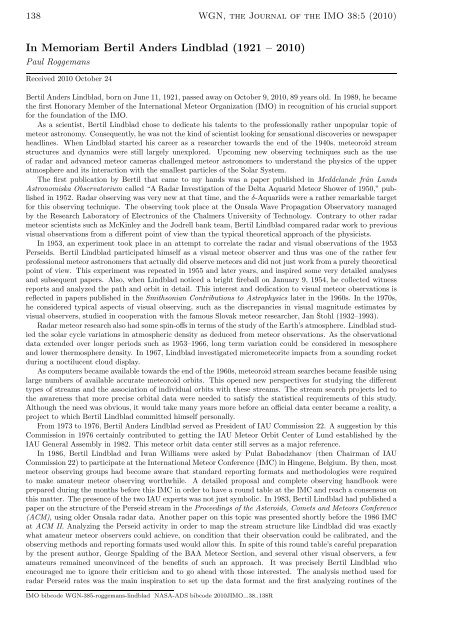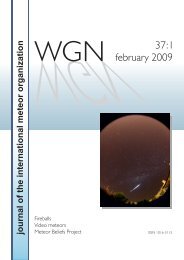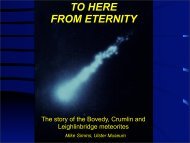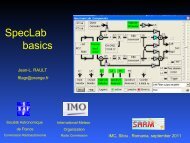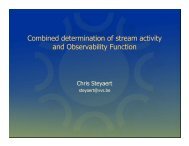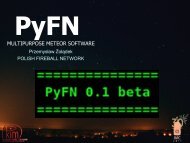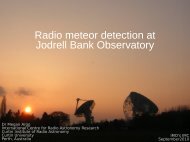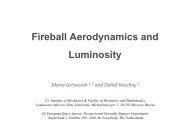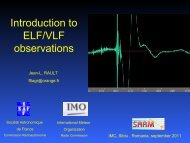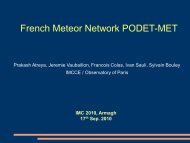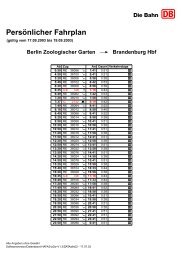Untitled - International Meteor Organization
Untitled - International Meteor Organization
Untitled - International Meteor Organization
You also want an ePaper? Increase the reach of your titles
YUMPU automatically turns print PDFs into web optimized ePapers that Google loves.
138 WGN, the Journal of the IMO 38:5 (2010)<br />
In Memoriam Bertil Anders Lindblad (1921 – 2010)<br />
Paul Roggemans<br />
Received 2010 October 24<br />
Bertil Anders Lindblad, born on June 11, 1921, passed away on October 9, 2010, 89 years old. In 1989, he became<br />
the first Honorary Member of the <strong>International</strong> <strong>Meteor</strong> <strong>Organization</strong> (IMO) in recognition of his crucial support<br />
for the foundation of the IMO.<br />
As a scientist, Bertil Lindblad chose to dedicate his talents to the professionally rather unpopular topic of<br />
meteor astronomy. Consequently, he was not the kind of scientist looking for sensational discoveries or newspaper<br />
headlines. When Lindblad started his career as a researcher towards the end of the 1940s, meteoroid stream<br />
structures and dynamics were still largely unexplored. Upcoming new observing techniques such as the use<br />
of radar and advanced meteor cameras challenged meteor astronomers to understand the physics of the upper<br />
atmosphere and its interaction with the smallest particles of the Solar System.<br />
The first publication by Bertil that came to my hands was a paper published in Meddelande från Lunds<br />
Astronomiska Observatorium called “A Radar Investigation of the Delta Aquarid <strong>Meteor</strong> Shower of 1950,” published<br />
in 1952. Radar observing was very new at that time, and the δ-Aquariids were a rather remarkable target<br />
for this observing technique. The observing took place at the Onsala Wave Propagation Observatory managed<br />
by the Research Laboratory of Electronics of the Chalmers University of Technology. Contrary to other radar<br />
meteor scientists such as McKinley and the Jodrell bank team, Bertil Lindblad compared radar work to previous<br />
visual observations from a different point of view than the typical theoretical approach of the physicists.<br />
In 1953, an experiment took place in an attempt to correlate the radar and visual observations of the 1953<br />
Perseids. Bertil Lindblad participated himself as a visual meteor observer and thus was one of the rather few<br />
professional meteor astronomers that actually did observe meteors and did not just work from a purely theoretical<br />
point of view. This experiment was repeated in 1955 and later years, and inspired some very detailed analyses<br />
and subsequent papers. Also, when Lindblad noticed a bright fireball on January 9, 1954, he collected witness<br />
reports and analyzed the path and orbit in detail. This interest and dedication to visual meteor observations is<br />
reflected in papers published in the Smithsonian Contributions to Astrophysics later in the 1960s. In the 1970s,<br />
he considered typical aspects of visual observing, such as the discrepancies in visual magnitude estimates by<br />
visual observers, studied in cooperation with the famous Slovak meteor researcher, Jan Štohl (1932–1993).<br />
Radar meteor research also had some spin-offs in terms of the study of the Earth’s atmosphere. Lindblad studied<br />
the solar cycle variations in atmospheric density as deduced from meteor observations. As the observational<br />
data extended over longer periods such as 1953–1966, long term variation could be considered in mesosphere<br />
and lower thermosphere density. In 1967, Lindblad investigated micrometeorite impacts from a sounding rocket<br />
during a noctilucent cloud display.<br />
As computers became available towards the end of the 1960s, meteoroid stream searches became feasible using<br />
large numbers of available accurate meteoroid orbits. This opened new perspectives for studying the different<br />
types of streams and the association of individual orbits with these streams. The stream search projects led to<br />
the awareness that more precise orbital data were needed to satisfy the statistical requirements of this study.<br />
Although the need was obvious, it would take many years more before an official data center became a reality, a<br />
project to which Bertil Lindblad committed himself personally.<br />
From 1973 to 1976, Bertil Anders Lindblad served as President of IAU Commission 22. A suggestion by this<br />
Commission in 1976 certainly contributed to getting the IAU <strong>Meteor</strong> Orbit Center of Lund established by the<br />
IAU General Assembly in 1982. This meteor orbit data center still serves as a major reference.<br />
In 1986, Bertil Lindblad and Iwan Williams were asked by Pulat Babadzhanov (then Chairman of IAU<br />
Commission 22) to participate at the <strong>International</strong> <strong>Meteor</strong> Conference (IMC) in Hingene, Belgium. By then, most<br />
meteor observing groups had become aware that standard reporting formats and methodologies were required<br />
to make amateur meteor observing worthwhile. A detailed proposal and complete observing handbook were<br />
prepared during the months before this IMC in order to have a round table at the IMC and reach a consensus on<br />
this matter. The presence of the two IAU experts was not just symbolic. In 1983, Bertil Lindblad had published a<br />
paper on the structure of the Perseid stream in the Proceedings of the Asteroids, Comets and <strong>Meteor</strong>s Conference<br />
(ACM), using older Onsala radar data. Another paper on this topic was presented shortly before the 1986 IMC<br />
at ACM II. Analyzing the Perseid activity in order to map the stream structure like Lindblad did was exactly<br />
what amateur meteor observers could achieve, on condition that their observation could be calibrated, and the<br />
observing methods and reporting formats used would allow this. In spite of this round table’s careful preparation<br />
by the present author, George Spalding of the BAA <strong>Meteor</strong> Section, and several other visual observers, a few<br />
amateurs remained unconvinced of the benefits of such an approach. It was precisely Bertil Lindblad who<br />
encouraged me to ignore their criticism and to go ahead with those interested. The analysis method used for<br />
radar Perseid rates was the main inspiration to set up the data format and the first analyzing routines of the<br />
IMO bibcode WGN-385-roggemans-lindblad NASA-ADS bibcode 2010JIMO...38..138R


